The European Championship 1150
The feudal social system starts to dominate in Europe. It was based on a network of inter-dependability, privileges, and inequality among people. The Second Crusade ends in mid-12th century. Norman dukes have, through conquest and marriage alliances, held power from the Kingdom of England in the north to vast territories in the south of France. Also, the Normans consolidate their power in whole Sicily and the south of the Apennine Peninsula. In the new Roman Empire, which will soon gain the epithet of “Holy,” the conflicts for the throne continue. At the same time, there was a serious conflict between the pope and the Emperor. The Iberaian Peninsula was divided into Muslim and Christian parts. In the eastern Europe the Land of the Rus existed in the conditions of a permanent disorder.
In mid-12th century, Norman dukes have, through conquest and marriage alliances, held power from the Kingdom of England in the north to vast territories in the south of France. Poland broke down into small semi-independent principalities. The King of Leon recognizes the independence of Portugal, which changes its status from county to kingdom. The Normans consolidate their power in whole Sicily and the south of the Apennine Peninsula with Naples. In addition to that, the Second Crusade ends in mid-12th century as well. Ever since the Islamic Turks, Seljuks, had, at the end of the 11th century, conquered Jerusalem, the threatened “Holy Land” became the homeland in need of defense, so many Christian noblemen have, at the pope’s behest, mounted a military offensive to retake the city (1095 AD). Thus started the long-lasting so-called Crusades in the area of the Middle East, wars between Christian and Muslim forces. The Crusades testify to the unity of the politically fragmented Europe through Christianity, as the wars became an expression of mass movements, adventures, collective passions, found in all of the innumerable small states.
In the new Roman Empire, which will soon gain the epithet of “Holy,” the conflicts for the throne continue, and the nobility will either take the side of the Emperor or his opponents, which constituted the start of the so-called conflicts between Guelphs and Ghibellines. The Emperor’s rule will often be met with disputes and rebellions from the most powerful noblemen. This will also be in direct connection with the conflict between the pope and the Emperor, which had started after the final Schism, after which nobody disputed the pope’s spiritual guidance. Generally, the reason for that was that the Church had attempted to rule the state, and the Emperor had attempted to rule the Church. At first it revolved around placing the members of the clergy in the service, and this struggle grew into the struggle for universal power.This conflict seemed unbalanced in the beginning since the Empire possessed a much stronger military, but the pope had the horrors of hell at his disposal, as well as curses, and the punishment of permanent excommunication, which had proven to be a terrifying weapon in the religious medieval society full of superstition. The key method of the pope’s strategy was the same one the Emperor used– divide and rule. Just as the Emperors instigated discord and persuaded priests to remove “unworthy” popes, so had the popes persuaded the Emperor’s vassals to remove the “unworthy” Emperors. Vassals against their rulers, sub-vassals against vassals, secular upper classes against the upper classes of the Church loyal to the Emperor, citizens against bishops, serfs against their masters – whoever had hated the Emperor and raised his voice against him could be given the blessing of the Church, provided they stand by the pope. To stop desertion, Emperors had to hand out honors.
Generally, the Middle Ages were dominated by the feudal social system (lat. Feudum – land property), which is based on a network of inter-dependability, privileges, and inequality among people, and even among the privileged, as well as the unprivileged classes, there were different levels which made themselves apparent in the way of life, the power they possessed, as well as reputation, or the deference towards their seniors. The fate of an individual was sealed at their birth. Thanks to the relative stability of literacy among agrarian communities, sharp demarcation of the populace into classes was possible to establish without creating tensions. On the contrary, by putting an emphasis on absolute power and inequality, they had gained strength and became acceptable, having an aura of inevitability, permanence, and as being the natural order of things. The Church, especially the upper clergy as the privileged class, supported the feudal order and the class society. Christian humility and deference to authority that they generally preached took precedence over human dignity.

Sources
- Marc BLOCH, Feudalno društvo, Zagreb, 2001.
- Fernard BRAUDEL, Civilizacije kroz povijest, Zagreb, 1990.
- Ernest GELLNER, Nacije i nacionalizam, Zagreb, 1998.
- Grupa autora, ''Širenje znanja'': Velika ilustrirana enciklopedija, Zagreb, 2009.
- Michael JORDAN, U ime Božje : nasilje i razaranje u svjetskim religijama, Zagreb 2008.
- Petar KORUNIĆ, ''Porijeklo, integracija i budućnost nacije'', Etničnost i povijest (ur.Emil Heršak), Zagreb, 1999.
- Jacques LE GOFF, Civilizacija srednjovjekovnog Zapada, Zagreb 1998.
- Roberto LOPEZ, Rođenje Evrope : stoljeća V-XIV, Zagreb, 1978.
- Marko PIJOVIĆ, ''Demistificiranje ''etniciteta'' '', Historijska traganja, 10/2012.
- Sources for maps
- Stem duchy: https://en.wikipedia.org/wiki/Stem_duchy
- Navarra: http://www.lrc.salemstate.edu/aske/maps/navarre.htm
- Portugal: https://en.wikipedia.org/wiki/Portugal portugal 1150
- Kingdom of Naples: https://en.wikipedia.org/wiki/Norman_conquest_of_southern_Italy
- Kiew: https://sites.google.com/a/umich.edu/imladjov/maps
- Swabia https://en.wikipedia.org/wiki/Duchy_of_Swabia
- Photo: Krak of Chevaliers
- https://pixabay.com/en/krak-of-chevaliers-crusader-syria-1078528/
